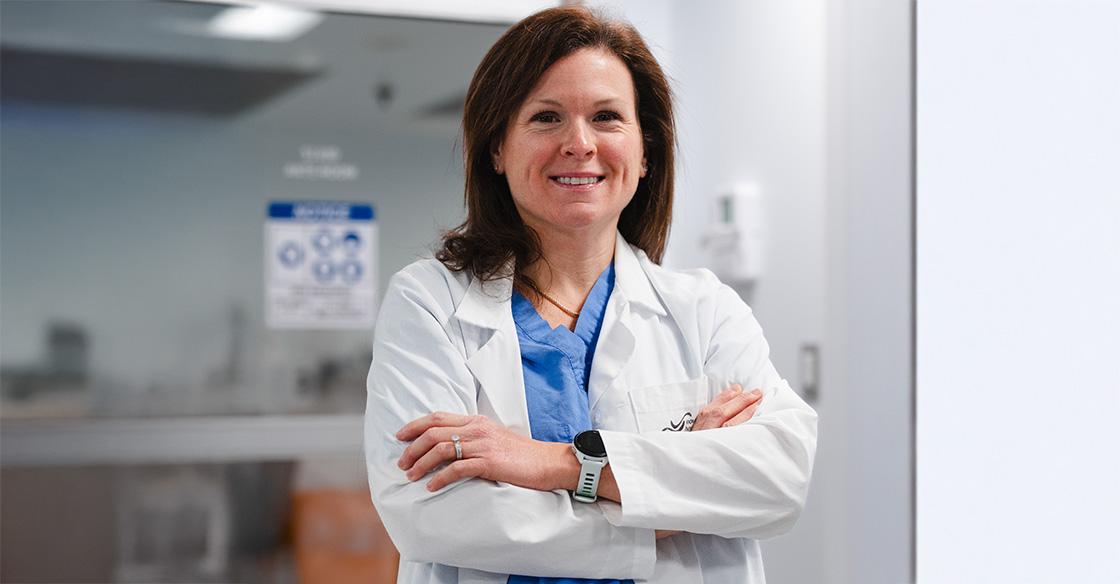
Since 2019, surgical robotics has been transforming care at the QEII Health Sciences Centre — thanks to the generosity of QEII Foundation donors. That year, community support brought Atlantic Canada its very first surgical robot, the da Vinci X, enabling more than 1,600 procedures to date for those facing prostate, kidney, gynaecological and ear, nose and throat (ENT) cancers.
The success of that first robot has fueled an urgent need for a second system — the latest and most advanced model, the da Vinci Xi. As part of the QEII Foundation’s Centre of Excellence in Robotics project, this investment will allow care teams to treat more patients, across more specialties, with even greater precision.
Not all patients require robot-assisted surgery but, for those that do, this technology is truly life-changing. For Dr. Stephanie Scott, Division Head of Gynaecologic Oncology at the QEII, this technology is personal. She has been using the da Vinci robot firsthand to treat women with endometrial and other gynaecological cancers — many of whom would have faced longer, riskier recoveries without it.
In this Q&A, Dr. Scott shares how surgical robotics is changing the future of care for patients and families across Atlantic Canada.
Q: What is the da Vinci robot and why is it such a powerful tool for patient care?
Dr. Scott: The da Vinci robot is one of the most advanced surgical robots in the world. It allows us to perform very complicated procedures through extremely small incisions. With a 3D view and incredible precision, it’s an innovative tool – controlled entirely by the surgeon – that helps us provide the best possible care for patients.
Q: How does minimally-invasive surgery change the patient experience?
Dr. Scott: It’s a game changer. Patients often have fewer complications, less pain, and can get back to their families and daily lives so much faster. They can have this surgery close to home and often return home the very same day. That’s a huge shift compared to traditional open surgery.
Q: Can you share how the QEII's current surgical robotics technology is impacting women with endometrial cancer?
Dr. Scott: Endometrial cancer is the most common gynaecologic malignancy we treat. The robot allows us to offer minimally-invasive surgery instead of large incisions, which can mean less pain, less bleeding, and faster recoveries. For many women, this is curative surgery. In some cases, it even makes surgery possible when patients might not have been candidates otherwise. These are our mothers, sisters, daughters, friends, and wives — and, in many cases, they get to go home to the things that matter most, faster.
Q: How does robot-assisted endometrial cancer surgery compare to traditional open surgery?
Dr. Scott: Traditionally, we would need a large incision in the abdomen, sometimes from the pubic bone to above the belly button. That often meant a four-day hospital stay, a higher risk of wound complications, and prolonged recovery.
With the da Vinci, we use incisions that are only eight millimetres. The robotic arms mimic all the motions of open surgery, but with a magnified 3D view that allows for even more precision. Patients go home sooner, often needing nothing more than Tylenol or Advil for pain.
Q: Beyond patient outcomes, what does this technology mean for the QEII’s ability to recruit and retain surgeons?
Dr. Scott: Surgeons want to provide the best care with the best tools. Access to surgical robotics is critical for recruitment and retention. Having the da Vinci — and soon, the da Vinci Xi — ensures we can attract and keep top surgeons who want to practice here in Atlantic Canada. It’s played a critical role in bringing surgeons from across Canada and even the U.S. to practice here, at the QEII.
Q: Why is funding a second da Vinci robot for the QEII so important?
Dr. Scott: From a gynae-oncology perspective, there are more women that could benefit from this surgical robotics technology right now – but due to limited access and competing demands, we're really reserving it for the patients that need it the most; often the highest risk patients.
So the benefits include increasing access to the robot-assisted procedures we currently offer, as well as helping us expand to treat more gynaecologic cancers and precancerous conditions in the future. An additional robot also means more disciplines and care areas get to utilize this technology for their patients, which may otherwise be out of reach without the support of donors.
Q: What would you say to the donors who will help fund this technology and support the Centre of Excellence in Robotics? What sort of impact are they making possible with their gift?
Dr. Scott: First and foremost, I’d say ‘thank you.’ Through your generous donation, you're changing patients' lives. You're changing the care that they can access. You're giving them more time with their families. You're often giving them a second chance. You're giving them surgeries that may not have otherwise been possible.
You’re giving surgical teams access to the best tools, research, data, and training to deliver the best possible care. You're not just supporting a hospital: you're empowering families, communities, and future generations.
Discover more about the da Vinci Xi robot and the QEII Foundation's Centre of Excellence in Robotics project, or donate now.